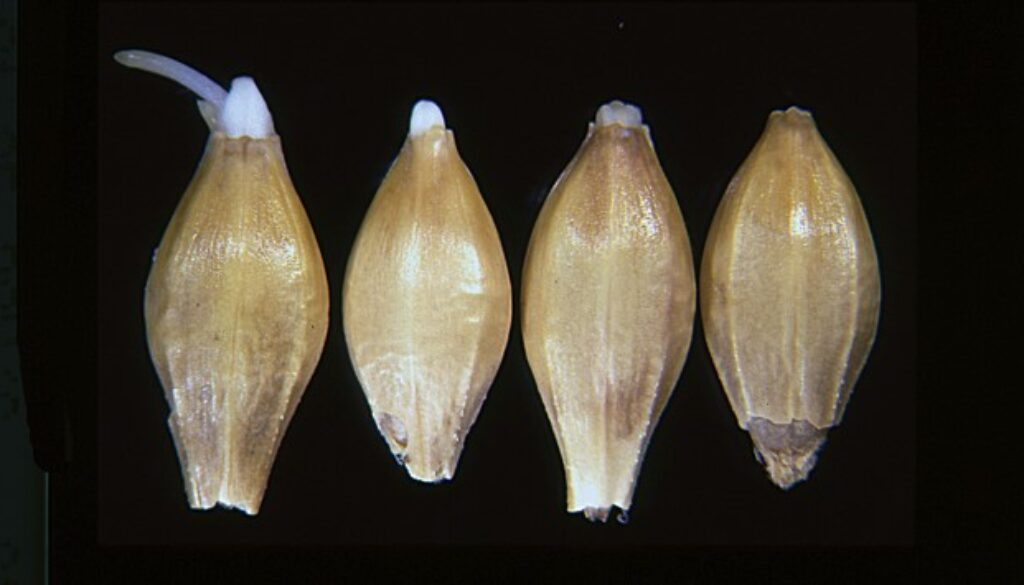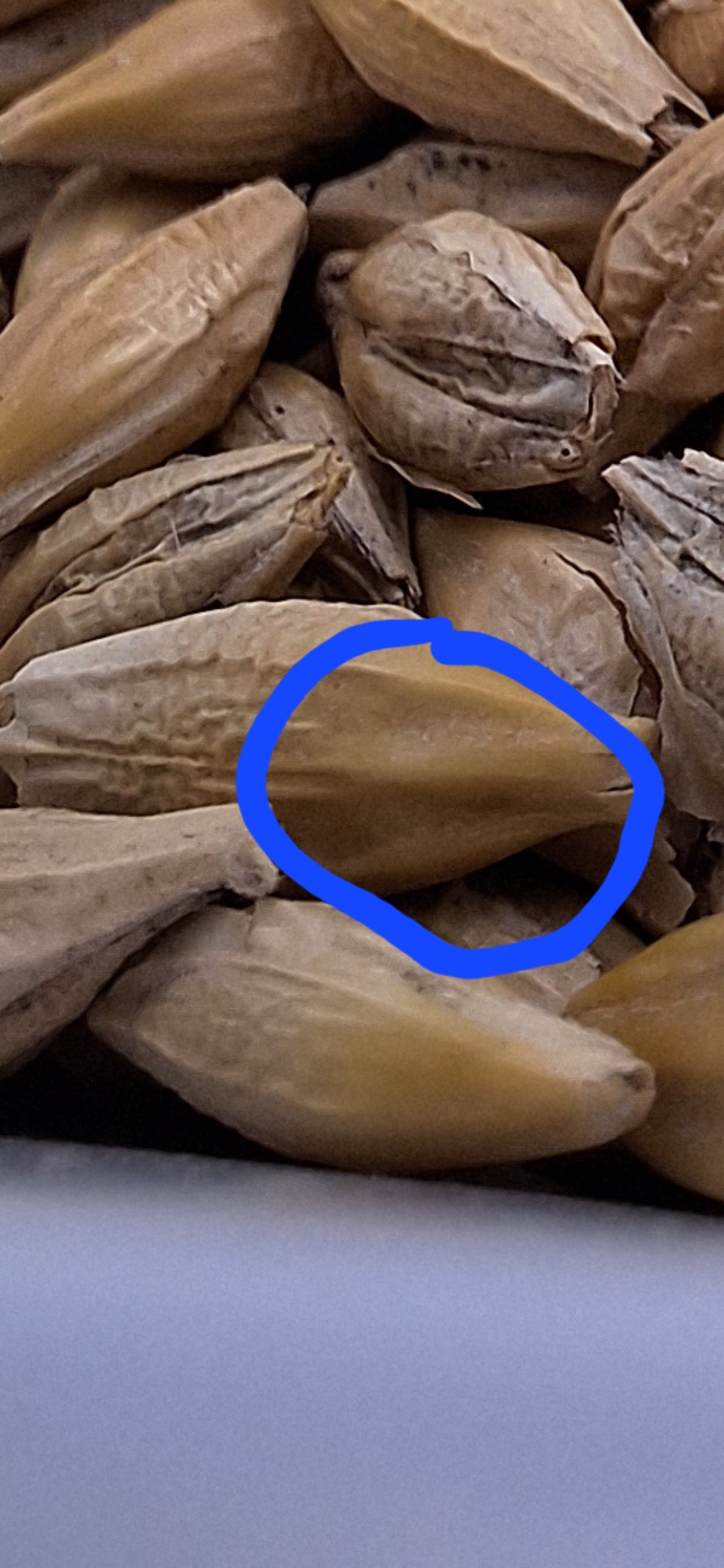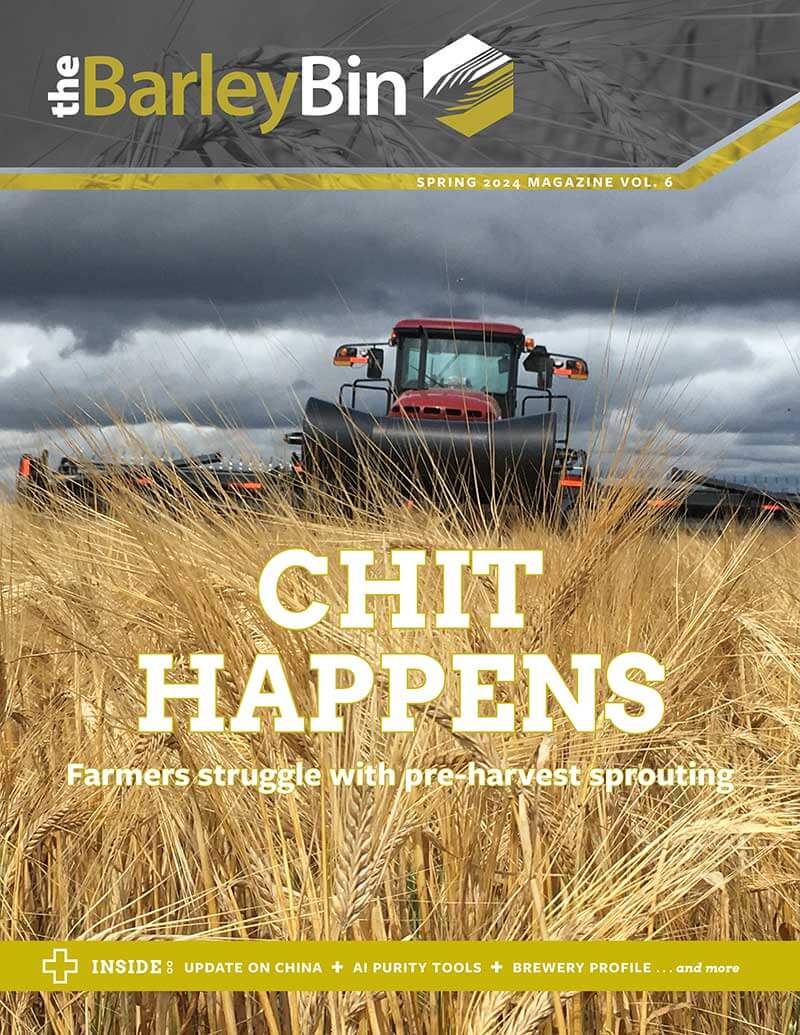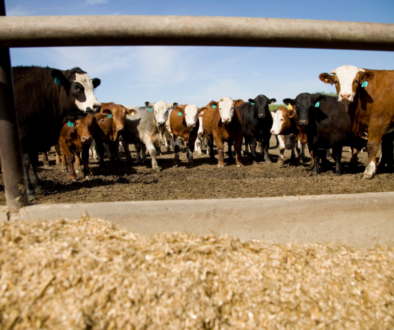Chit happens: Understanding pre-harvest sprouting challenges and future solutions
by Delaney Seiferling, Freelance Writer
When Keith Rueve took a sample of his malting barley to his local buyer last fall, he was surprised to be told it was 40% chitted. Although he knew there had been some untimely rains in his area in August, he also thought his barley had been green enough leading up to harvest that his crops wouldn’t be too heavily affected by the moisture.
“I was pretty comfortable that my barley wasn’t ready yet,” says Rueve, who farms south of Muenster. “I’ve seen barley chit before when it’s laying in a swath, but this was standing barley that wasn’t one hundred percent mature.”
Rueve says he swathed the barley around August 25 and picked it up before August 29. “Conditions were nice and dry when we harvested it.”
Untimely rains bring about pre-harvest sprouting (PHS)
Rueve wasn’t the only one to have a problem with pre-harvest sprouting (PHS) in barley last year. Although the growing season was generally characterized as too hot and dry, certain pockets of the province — mainly the northwest, southwest, and northeast – saw untimely rainfalls in mid-August that led to reports of PHS.
Early seeding and variety choices can reduce the market risks of pre-harvest sprouting
Zenneth Faye, who farms near Foam Lake, SK, saw many of his neighbours suffer similar fates to Rueve. He believes the only reason he didn’t is because he seeded his barley early.
“Seeding early usually works a bit better,” he says. “You do have a better chance to avoid later harvest weather issues with moisture if you get it in early enough.” But he says seeding early is not always an option — or can be a challenge. He planted his barley three different times last year.
“We were lucky that, because of the spread in times of seeding, we were able to dodge the moisture that did come between the fog and high humidity that we had this fall for a few days.” Another factor affecting pre-harvest sprouting levels last year was variety choice.
Lower-enzyme varieties, such as CDC Churchill and CDC Copeland, tend to be less prone to PHS than higher-enzyme varieties such as AC Metcalfe, CDC Fraser and AAC Prairie.
CDC Fraser, which is climbing in popularity amongst Saskatchewan growers, accounted for 6.5% of seeded malt barley acreage in Saskatchewan last year.
Peter Watts of the Canadian Malting Barley Technical Centre (CMBTC) says these issues heavily impacted exports. “It affected so much CDC Fraser that the grain companies weren’t able to source a commercial cargo of 25,000 tonnes this year,” he says.
The problem hit hard at a farm level as well. Rueve says he was able to sell his malting barley as feed, but he still took a big hit on price. “It’s at least a dollar a bushel difference,” he says.
Developing varieties resistant to pre-harvest sprouting (PHS)
For next year, he says he’ll be growing something different. But in the longer term, some tools are in the works to help growers take back control over this frustrating issue.
SaskBarley has recently invested in research to develop newer varieties with optimal dormancy levels, as dormancy is the trait that allows seeds to delay germination until after maturity. The project, which kicked off last year and will wrap up in 2025, will find and incorporate new malting barley traits to allow for the right balance of dormancy in the seed. This means that varieties will have a lower risk of PHS but lose their dormancy after harvest to still allow for quick and efficient germination when it comes to malting.
This will give growers who tend to experience high levels of humidity or moisture and/or who have had issues with PHS another option, says SaskBarley’s Research and Extension Manager Mitchell Japp. “We understand the challenges that preharvest sprouting presents and that varieties with PHS resistance helps barley growers,” he says. “This is an opportunity to improve PHS resistance and still limit dormancy for consistent malting performance.”
He says SaskBarley also has a project concept in development that will review barley varieties for PHS resistance, in order to provide growers with more information to make the best strategic choices for their operations. “PHS resistance ratings, like ratings for resistance to lodging or diseases, will help growers choose a barley variety that works for their own operation.”
Follow best practices to avoid pre-harvest sprouting disasters
In the meantime, growers can take comfort in the fact that there are more malting barley varieties available to them today than there were ten years ago, as market acceptance for newer varieties is slowly growing.
This means growers can increasingly choose lower enzyme varieties, such as CDC Churchill, without worrying if there will be a market for them, says Watts. “It doesn’t mean that Churchill can’t sprout, but it’s a lot less prone to sprouting in the field than some of the higher enzyme varieties,” Watts says.
Regardless of what variety they’re growing though, growers are also still advised to follow best practices in order to control PHS to the best of their abilities, says Japp. “From a management perspective, targeting barley harvest at 17-18% grain moisture content is optimal for preserving malt quality, as long as there is a willingness to dry the grain low and slow to preserve malt germination,” he says.
Harvesting early can also increase flexibility with other crops and reduce potential impacts from fall precipitation, he says. Faye also believes seeding dates matter. “We know, in the grand scheme of things, seeding early does give you a bit of an edge.”
Want more?
Find more barley production and research information in the Spring-Summer 2024 Edition of the BarleyBin Magazine:
- Q&A with Peter Watts: “It’s going to be a challenge for us to sell barley into China in this current year.” Page 9
- Malt evolution: Growers embrace new varieties, propelling innovation in brewing and malting sectors. Page 11
- Keeping stress low for your seed this spring: Exploring the dynamic relationship between seed treatments and plant health and performance. Page 13
- Unlocking growth: Understanding the impact of plant growth regulators on barley yield and lodging reduction. Page 14
- A multi-million dollar commitment to innovation: SaskBarley’s research investments promise breakthroughs in barley production. Page 16
- Cutting costs and time: ZoomAgri’s AI varietal purity assessment tool is a game changer. Page 17
- If you brew it, they will come: With Great Western you don’t have to choose between buying local and buying the best. Page 18







